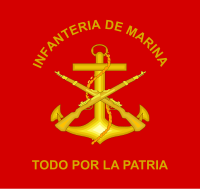Mexican Marines
| Infantería de Marina | |
|---|---|

Naval Infantry emblem
|
|
| Active | 1822–present |
| Country |
|
| Branch |
|
| Type | Naval infantry |
| Role | Amphibious warfare |
| Size | 25,000 |
| Garrison/HQ | Mexico City |
| Motto(s) |
En la tierra, en el aire y en el mar (English: On land, air and sea) Todo por la Patria (English: All for the Fatherland) |
| Colors | Scarlet |
| Anniversaries | June 1, Marine Day |
| Commanders | |
| Current commander |
Admiral Mariano Francisco Saynez Mendoza |
| Insignia | |
| Flag |  |
The Naval Infantry Force (Spanish: Fuerza de Infantería de Marina) are the marine corps and amphibious infantry force of the Mexican Navy. The main task of the Infantería de Marina is to guarantee the maritime security of the country's ports and external and internal defense of the country. To accomplish these responsibilities, the corps is trained and equipped to take on any type of operations from Sea, Air and Land.
The Naval Infantry Corps was reorganized in 2007–2009 into 30 Naval Infantry Battalions (Batallones de Infantería de Marina—BIM), a paratroop battalion, a battalion attached to the Presidential Guard Brigade, two Fast Reaction Forces with six battalions each, and three Special Forces groups. The Naval Infantry are responsible for port security, protection of the ten-kilometer coastal fringe, and patrolling major waterways.
To accomplish the necessary services and tasks, the Naval Infantry's overall responsibilities are to develop amphibious naval capabilities in the areas of operations of the Navy in order to mobilize naval troops immediately and decisively.
The Naval Infantry execute the following tasks:
Since the start of President Felipe Calderón's war on the drug cartels, the Infantería de Marina's role has grown from maritime and port security to land based operations in combating organized crime, drug trafficking, extermination of marijuana fields, drug interdictions at sea, and also participating in arrest of cartel suspects.
The navy has carried out permanent intense anti-narcotic operations. Such tasks as the extermination of marijuana fields which mostly takes place in the north-western part of the country is done by first locating the fields by satellite or simply by air reconnaissance, then sending a team of marines to eradicate the cannabis plants. One of its big seizures was in late October 2007, when navy personnel in a joint operation with other agencies seized 23 tons of cocaine in the port city of Manzanillo, Colima. Due to its actions, the Navy and in kind the Naval Infantry Force has risen in stature in the United States.
Drug interdiction at sea is also part of the Navy's strategy to combat drug trafficking, this came to light when on July 16, 2008, the Navy intercepted a 10-metre (33 ft) long narco submarine travelling about 200 kilometres (120 mi) off the southwest of the state of Oaxaca; in a raid, Navy Special Forces rappelled from a helicopter on to the deck of the narco submarine and arrested four smugglers before they could scuttle their vessel. The vessel was found to be loaded with 5.8 tons of cocaine and was towed to Huatulco, Oaxaca, by a Navy patrol boat.
...
Wikipedia
